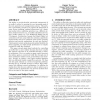Free Online Productivity Tools
i2Speak
i2Symbol
i2OCR
iTex2Img
iWeb2Print
iWeb2Shot
i2Type
iPdf2Split
iPdf2Merge
i2Bopomofo
i2Arabic
i2Style
i2Image
i2PDF
iLatex2Rtf
Sci2ools
ATAL
2008
Springer
2008
Springer
Regulating air traffic flow with coupled agents
The ability to provide flexible, automated management of air traffic is critical to meeting the ever increasing needs of the next generation air transportation systems. This problem is particularly complex as it requires the integration of many factors including, updated information (e.g., changing weather info), conflicting priorities (e.g., different airlines), limited resources (e.g., air traffic controllers) and very heavy traffic volume (e.g., over 40,000 daily flights over the US airspace). Furthermore, because the Federal Flight Administration will not accept black-box solutions, algorithmic improvements need to be consistent with current operating practices and provide explanations for each new decision. Unfortunately current methods provide neither flexibility for future upgrades, nor high enough performance in complex coupled air traffic flow problems. This paper extends agent-based methods for controlling air traffic flow to more realistic domains that have coupled flow pat...
| Added | 12 Oct 2010 |
| Updated | 12 Oct 2010 |
| Type | Conference |
| Year | 2008 |
| Where | ATAL |
| Authors | Adrian K. Agogino, Kagan Tumer |
Comments (0)

